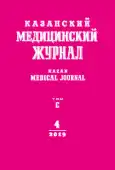Justification for preservation of the projected skin flap above the tumor during surgical treatment of primary resectable breast cancer
- Authors: Khamitov AR1, Ismagilov KK.2
-
Affiliations:
- Tatarstan Regional Clinical Cancer Center
- Kazan State Medical Academy
- Issue: Vol 100, No 4 (2019)
- Pages: 710-718
- Section: Clinical experiences
- URL: https://journal-vniispk.ru/kazanmedj/article/view/15561
- DOI: https://doi.org/10.17816/KMJ2019-710
- ID: 15561
Cite item
Full Text
Abstract
Aim. Improvement of the aesthetic outcomes of reconstructive plastic surgery for nodular breast cancer due to the scientific rationale of conservation of the projected skin flap and moving the postoperative scar to aesthetically acceptable zones.
Methods. Data of clinical and instrumental methods of investigation of 240 patients with primary resectable breast cancer were analyzed. The probability of involvement of the front layer of the superficial fascia in the projection of a malignant tumor depending on its clinical and topographic anatomical figures was estimated.
Results. The study revealed that the fascia involvement does not depend on the skin flattening. The skin flattening is an indirect sign of superficial tumors having a probability of intimate adherence of the tumor to the fascia of 31.8±0.401%. In turn, the intimate adherence of the tumor to the front layer of the superficial fascia with a probability of its involvement of 39.3±0.41% is a significant risk factor for the projected skin flap involvement. It was also found that involvement of the fascia studied does not depend neither on the size of the tumor, nor on the nodal status, nor on the biological subtype. The key risk factor is the depth of the tumor.
Conclusion. The indication for the projection skin flap preservation is the location of a malignant tumor at a depth of more than 1.05 cm, at which the probability of affecting the fascia is statistically insignificant and is 1.7±0.1%, which requires placing the subcutaneous tissue resection line in the tumor projection from the side of preserved skin flap.
Full Text
##article.viewOnOriginalSite##About the authors
A R Khamitov
Tatarstan Regional Clinical Cancer Center
Author for correspondence.
Email: khamitovayrat@gmail.com
Kazan, Russia
K Kh Ismagilov
Kazan State Medical Academy
Email: khamitovayrat@gmail.com
Kazan, Russia
References
- Zlokachestvennye novoobrazovaniya v Rossii v 2017 godu (zabolevaemost' i smertnost'). (Malignancies in Russia in 2017 (incidence and mortality).) Ed. by A.D. Kaprin, V.V. Starinskiy, G.V. Petrova. Moscow: MNIOI im. P.A. Gertsena, filial FGBU “FMITs im. P.A. Gertsena” Minzdrava Rossii. 2018; 250 p. (In Russ.)
- Shirokova I., Prozherina Yu. Breast cancer: expert opinion. Remedium. 2016; (10): 53–58. (In Russ.)
- Zikiryakhodzhaev A.D., Rasskazova E.A. Oncoplastic resections for breast cancer. Onkologiya. Zhurnal imeni P.A. Gertsena. 2015; (4): 80–84. (In Russ.)
- Shushpanova O.V. Mental disorders in patients with breast cancer. Zhurnal nevrologii i psikhiatrii. 2011; (3): 90. (In Russ.)
- Toth B.A., Lappert P. Modified skin incisions for mastectomy: the need for plastic surgical input in preoperative planning. Plast. Reconstruct. Surg. 1991; 87 (6): 1048–1053. doi: 10.1097/00006534-199106000-00006.
- Carlson G.W., Bostwick J. 3rd, Styblo T.M. et al. Skin — sparing mastectomy. Oncologic and reconstructive considerations. Ann. Surg. 1997; 225: 570–575. doi: 10.1097/00000658-199705000-00013.
- Gerber B., Krause A., Reimer T. et al. Skin-sparing mastectomy with conservation of the nipple-areola complex and autologous reconstruction is an oncologically safe procedure. Ann. Surg. 2003; 238 (1): 120–127. doi: 10.1097/01.SLA.0000077922.38307.cd.
- Laronga C., Kemp B., Dohnston J. et al. The incidence of occult nipple-areola complex involvement in breast cancer patients receiving a skin-sparing mastectomy. Ann. Surg. Oncol. 1999; 6 (6): 609–613. doi: 10.1007/s10434-999-0609-z.
- Simmons R.M., Brennan M., Christos P. et al. Analysis of nipple/areolar involvement with mastectomy: can the areola be preserved? Ann. Surg. Oncol. 2002; 9 (2): 165–168. doi: 10.1245/aso.2002.9.2.165.
- Cense H.A., Rutgers E.J., Lopes Cardozo M. et al. Nipple-sparing mastectomy in breast cancer: a viable option? Eur. J. Surg. Oncol. 2001; 27: 521–526. doi: 10.1053/ejso.2001.1130.
- Petit J.Y., Veronesi U., Orecchia R. et al. Nipple-sparing mastectomy in association with intra operative radiotherapy (ELIOT): A new type of mastectomy for breast cancer treatment. Breast Cancer. Res. Treat. 2006; 96: 47–51. doi: 10.1007/s10549-005-9033-7.
- Wang J., Xiao X., Wang J. et al. Predictors of nipple-areolar complex involvement by breast carcinoma: histopathologic analysis of 787 consecutive therapeutic mastectomy specimens. Ann. Surg. Oncol. 2012; 19: 1174–1180. doi: 10.1245/s10434-011-2107-3.
- Munhoz A.M., Montag E., Filassi J.R., Gemperli R. Immediate nipple-areola-sparing mastectomy reconstruction: An update on oncological and reconstruction techniques. World. J. Clin. Oncol. 2014; 5 (3): 478–494. doi: 10.5306/wjco.v5.i3.478.
- Aerts L., Christiaens M.R., Enzlin P. et al. Sexual functioning in women after mastectomy versus breast conserving therapy for early-stage breast cancer: a prospective controlled study. Breast. 2014; 23 (5): 629–636. doi: 10.1016/j.breast.2014.06.012.
- Bayat A., McGrouther D.A., Ferguson M.W. Skin scarring. BMJ. 2003; 326 (7380): 88–92. doi: 10.1136/bmj.326.7380.88.
- Bershteyn L.M. Epidemy of “non-steroid triade” (obesity, diabetes, metabolic syndrome) and breast cancer. Zlokachestvennye opukholi. 2018; 8 (3S1): 5–8. (In Russ.)
- Alteri R., Barnes C., Burke A. et al. Breast cancer facts & figures 2013–2014. American Cancer Society, Inc. 2013; 40 p.
Supplementary files






